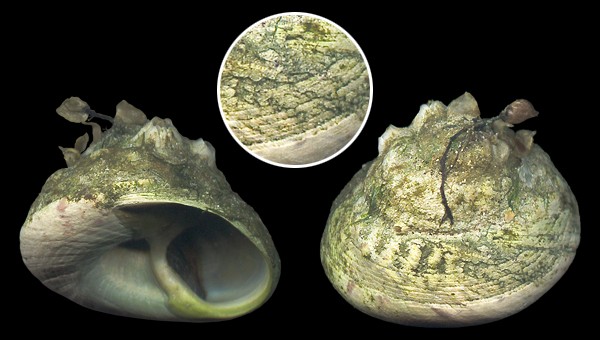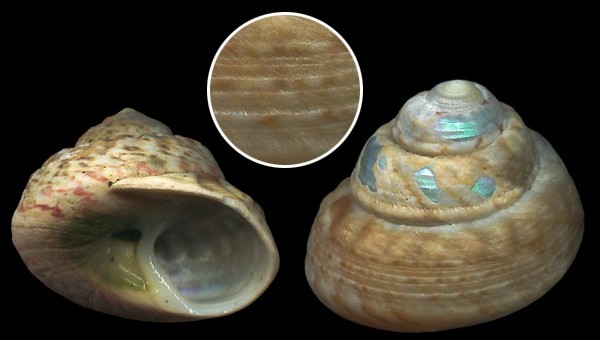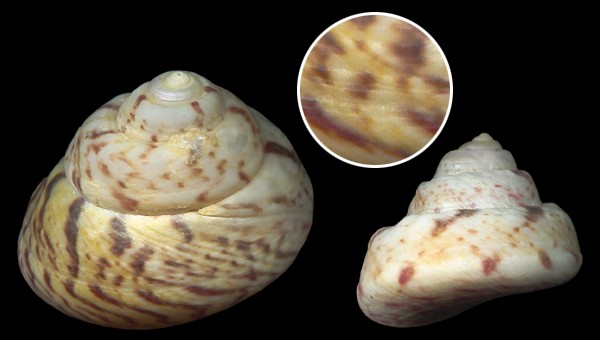| [Index] |
Gibbula magus (Linnaeus, 1767) at low tide in Brittany |
| |
|
28mm specimen in natural condition, from intertidal slopes near Saint-Malo, Côtes d'Armor.
The spiral cords and the knobby crown below the suture are typical. |
| |
 Pointe du Chevet Pointe du Chevet |
| |
 It's a place like hundreds of other places along the coast. A headland
slowly penetrates in the sea between two deep valleys. Here, the ridge does not dive at one go, but regularly reappears by small humps that are
so much reefs and islets to which a discreet and tenacious life clings, paradise for birds and plants; there is one that shields its stamens against
the mad wind by sheltering its organs inside a kind of bell like a weaver-bird's nest. It grows on the southern side of the rocks, the side that never
receives the full of the storm, which often comes from the northern quadrant: Channel islands, Casquets, Cross-Jobourg.
 The tidal flows built long rubble bars that meander from reef to reef. Centuries are not the main operative strengths there, but gravitation,
but Archimedes' principle: there is, on the two thirds of the elevation, a layer of gray clay (full
of Angel Wings!) above a slope of shelly sand that becomes muddy in the bottom; upon this bank, some shellgrit; then a good hat of fine
sand with, on top, the jetsam, the debris that are too large and too light to sink within the dune. Thereon a car runs, on the way to its island,
raising glorious sprays. Thereon, some dogs play and gambol; some people walk. The dogs draw loops and eights around the ramblers; the wind blows
off their barks, and brings back in exchange the pantings of an amphibian waggon that hurries down the shelf towards the mussel parks. This is a
waggon with a boat's prow, outboard motor, rudder, directional wheels, and the breath of an ancient locomotive; the whole caboodle produces funny
noises that sound like "steam-steam-steam-steam-steam", "pant-pant-pant-pant-pant".
 The rain stops short, and there is even a bit of shiny whiteness in the thick of the clouds; one could nearly feel the Sun's heat. And,
as we are now sheltered behind a rampart of large rocks, it becomes a little warm. The wind does not blow here, but ten meters above, a Gull
is in stationary flight. It takes an interest in what we are doing, because we collect shells; and human beings, with their skilled hands, always
discover some fabulous stuff that no peck could extract. In a word, it's worth staying near beachcombers; especially when they are about to picnic, of course. |
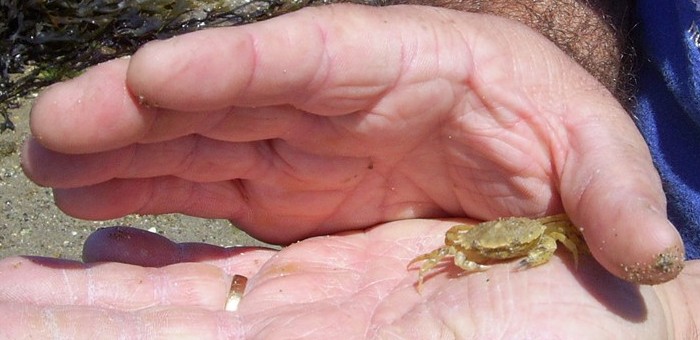 |
Baby Carcinus maenas (Linnaeus, 1758). This shore crab can reach 100mm, and darkens with age.
Juvenile are quite paler, with often sand & gravel-like patterns. Picture © Dominique Michel. |
 We meet a fisherman. He carries a heavy hamper full of ginormous wild oysters that he envelopped in large algae. On top of the pyramid, two ormers
sit in honour, which seem to be of good sizes. He is a local, engraved chapped bearing a comb-killer beard, with shorts, boots and beret, and wet from head to foot, but he doesn't care.
Moreover, to do the things correctly, one may not fear to be steeped. Trying to stay dry can be dangerous. Many people were drowned while shelling,
the body protected by a chest wader: they go too far, they stop prospecting too late after the tide turned, the sea flows up, fills the waders;
here they are ballasted, big balloons full of chilled water that slowly pushes them down to the bottom. They resist a piece of time, they renounce
and fall on these sand bars on which they walked a little hour ago. On the surface, the rescuers inspect the reefs; someone cries on the shore.
 If you want to dawdle along the way back, it's better to be dressed for snorkeling. Like this, you float, and the tidal streams push you quickly ashore.
You see many animals that begin to nose around: crazy fishes rush to the fields let by the receding Land, crabs fight for a piece of
saussage detached from its herd. You see also, dark apparitions, the bushes of algae, the hairy rocks that fly at your face.
You're disquieted, and justified to be so, as new kinds of threats appear. |
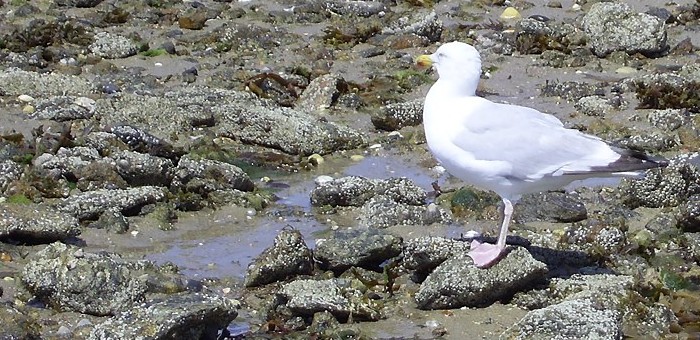 |
| Larus argentatus Naumann, 1840. Notice the red dot on the bill.
This dot is used by youngsters to start a reflex of regurgitation in the parents. Picture © Jean-Pol Michel. |
 On the shelf facing the open sea, I saw enormous Mactras, and some dead Waved Whelks, big, fat, large, as one will never see in fishmarkets,
where they display specimens fished too young; Scallops and Dog Cockles, sloughs of Spider Crabs; enough to give you the desire of a little dredging just offshore.
But I was not here for that; I wanted to meet some Gibbulas again, my beloved Turban Top-shells, which like to live in the shoal within the reef barrier,
a group of large pools that slowly empty. Besides, these are famous traps; often, the beasts realize the danger too late. The draining could let them dried up.
 And, with the preys, arrive the Herons. They catch the little fishes, the translucent shrimps. They walk precautiously, scanning the ground one step ahead like fossils hunters.
Then, they stay motionless for a long time, in order to let the water restore its mirror; afterwards, slowly, they scratch the bottom...
The shrimps come, planning to forage a bit; then comes the bill, which thrusts with violence. Panic. The alarm spreads in the pool.
Crazed fishes turn round faster and faster, burst the surface and draw perceptible tracks; at that time, the Terns, the Gulls charge and splash.
 This is endless; on the periphery, one or two Herons; in the center, like white meteors, the sea birds in fans of foam, the shoutings, the affray.
It's like in a tuna-net, like in the "Pêche au Thon" by Dali; the death spurts everywhere. Me, I watch the scene while eating my sandwich;
one cannot say it is enjoyable. The little sounds that my bag emits remind me all the life that I uprooted. This evening, one will die in boiling water.
These thoughts give me a quite vacant stare; a piece of saussage seizes the opportunity and breaks a way to freedom; one knows what will occur.
And this will rarely happen to a Gibbula magus, barring unexpected events, such as the encounter with a seashell collector fond of odd experiments, like, for example, this one:
 I grope in the bag for a magus, which I extract and put aside; I choose a little stone of a relevant size, I utter to call the bird
that watches my sandwich from yonder rock, and I fling up the stone; the bird flies off indolently and comes along, cruising around my rock.
 Good... I throw an other stone, but the animal was not prepared and plunged too late, the lure has disappeared among the thousands of other similar things
that are strewn about this portion of marine bottom. Nevertheless, I struck it, so to say; it's time to use my true snail. Let's try.
 Fire! The Gibbula rises in the sky and falls whirling down to the ground, pursued by the bird that pounces near the place where the shell crashed.
Then it walks quietly toward the victim, forages a while and finds it; the shell may have fallen upside down (the last whorl and the aperture are less dense than the remainder),
and the flaming Trocha-Red of the basis is certainly visible now, at least partially.
 That's hopeless: for many birds, a red stain is like a baby's dummy for an infant. The beast seizes its prey, takes wing and climbs in the sky; it releases the shell right
above a field of stones, and rushes in its wake. It disappears behind a rock... I did'nt hear the impact, the wind rubbed out the sound. |
| |
 Colour schemes Colour schemes |
| |
 Many Trochidae use two special colours, which could be regarded as a kind of family's flag:
a pine-green, more or less saturated, and a fabulous red made with carmine and magenta.
 The Gibbulas that live on rocks ( cineraria, umbilicalis, pennanti etc.) are marbled with
a pine-tree based colour scheme that suggests granulose surfaces, covered with micro-algae and organic debris, on which they are used to crawling.
Regarding the Turban Topshells, they bear different paintings. Because this species prefers gentle slopes; it lives on coarse sand, maybe a bit
muddy, among Zostera but not always, in Maerl beds but this is not a necessity. It lives in many environments, intertidally down to about
40m deep. It can even sleep in the wind, pending the tidal flow.
 Some of the best places where to find the animal at low tide, are these large fields, not too
slushy, sheltered between reefs and barriers, in 2cm of water for example. The birds, however skilled they may be, fly over these grounds without
ever noticing one magus: when it colonizes a shallow area, the species does not bear any bright red on the spire. |
|
24mm (left) & 26mm Turban Topshells, found on the shelf facing to sea, in a tide pool around a big stone. This
uniform colouring (right) is quite uncommon: most of the intertidal specimens have spotted patterns (as for the left one) that make them look like little
granitic stones. Notice the pronounced sutural cord, a feature rarely found in adult specimens. The eroded spire gives evidence of a life a
bit more restless than usual. Specimens live collected. |
|
26mm (left) & 20mm snails, from wide tide pools sheltered between reefs. They show extreme variants of
the pattern that is commonly borne by the shallow water specimens found in this spot. |
 In most cases, one would think that it's a pellet of ooze, a filthy stone.
Once cleaned, it appears that the prosocline patterns made use only of lowly tints that remind of mud, gravel, little stones; with a bit of mud
and algae on their shell, the snails look like wan things abandoned under the sun.
 The specimens with too much red tend to have bad ends. One finds some chips amid the rocks, while one never meets many brownish or greenish
fragments; apparently, greenish or brownish Gibbulas have safer lives. The birds don't attack them. |
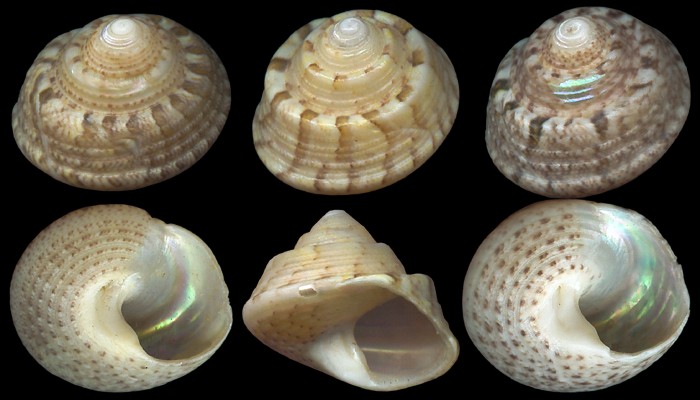 |
| Young shells from muddy sands in shallow water. 17-18mm. There is some possible confusion between young magus
and Gibbula albida (Gmelin, 1791). The shape is often angular, with sometimes a row of knobs below the suture. The older the shell, the
deeper it lives; there, patterns tinged with red begin to predominate. |
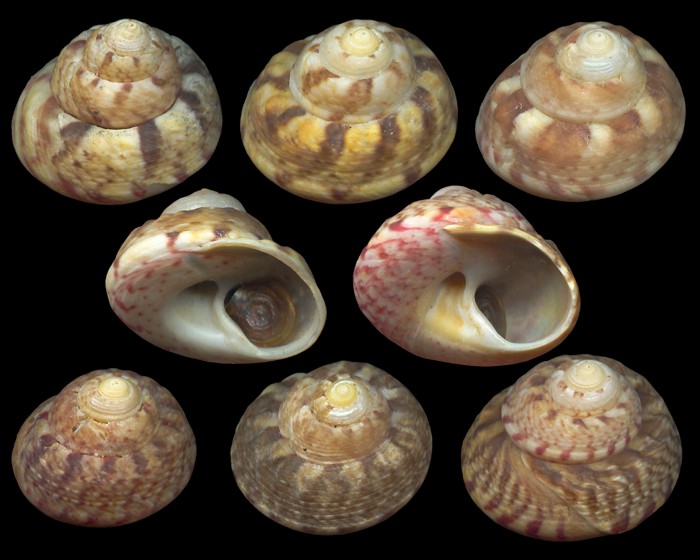 |
| Specimens from outer field at the foot of reefs, western side of les Hébihens island. 17-24mm.
The base of the shell is often very "trochy", with red spiral lines or prosocline flames, like in genus Tectus. |
 As one goes far offshore during Spring tides, one finds more and more
red in these shells, as if it was their basic colour, while the ugly tints were only optional. I suppose that this tendancy is strenghtened in subtidal
bottoms. Always, try to stay unnoticed: the sea is blue because its reflects this colour complementary of the red, which is absorbed first. Thus, under
water, a red shell could become progressively undefinable. |
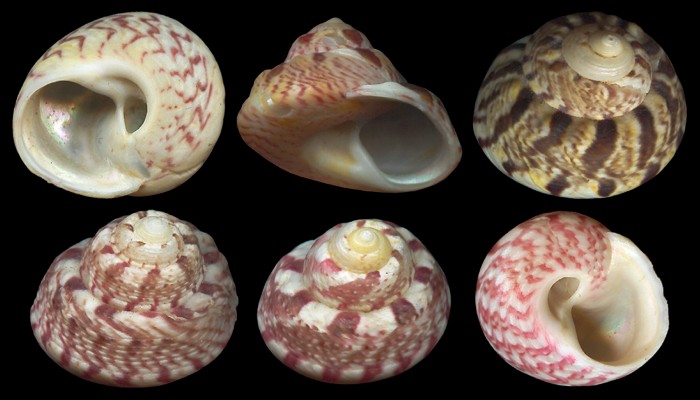 |
At extreme low tide, far offshore, in a place that often remains under water during long months.
The shells are now almost totally red, with stronger patterns than before. 19-21mm. |
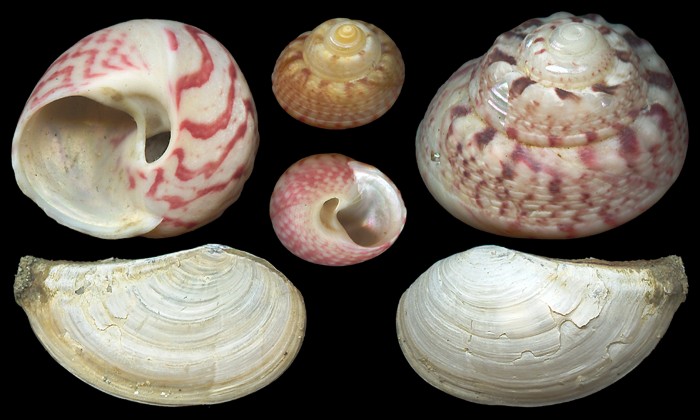 |
Beachstormed, on a sand bank with Pandora inaequivalvis (Linnaeus, 1758), exposed to open sea. 13-28mm. |
| |
 Passport to a quiet life Passport to a quiet life |
| |
 Since D.V. Denon, one knows that discretion is the very first of all the virtue;
"one owes it many instants of happiness". In a 50m wide channel between Larmor-Baden and Berder Island, Turban Topshells live in prodigious
number among yellowish and grayish pebbles to which all look like. |
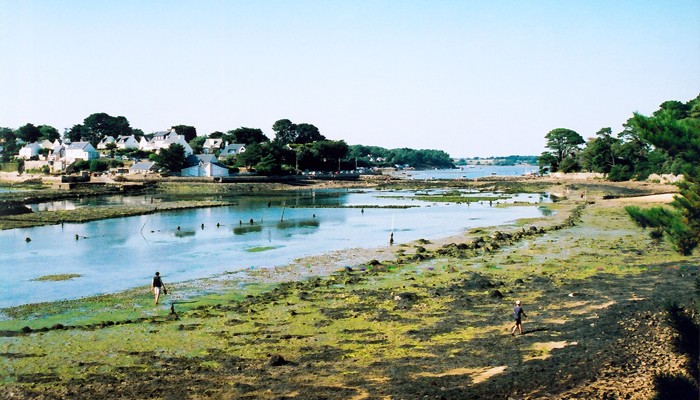 |
 Larmor-Baden (left) and Berder island (right), Gulf of Morbihan, southern Brittany.
Except during Spring tides, this pool is never totally drained. Near the submerged road that crosses the channel, there is still a foot of water,
in which live the Turban Topshells. The colony is isolated from those living downstream by an abominable mud-bank. Then, contacts with the Gulf
are gained by crossing the causeway at high tide. Nevertheless, the other side is not as hospitable. |
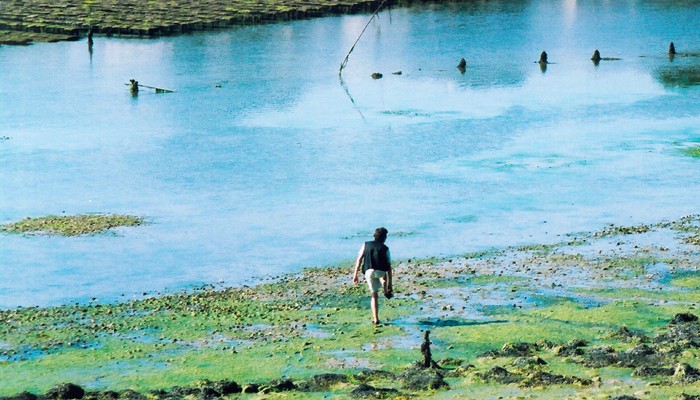 |
The flat is very muddy, especially near the oysters shelves. The Gibbulas live on stones and gravel, in bottoms
like the one in the foreground. I'll try to hunt between the shore and the first wooden piles, in 5 to 50cm deep. |
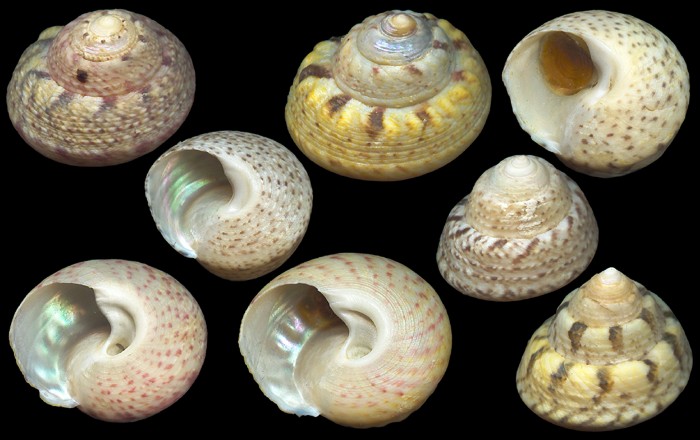 |
The catch gives interesting variations. In the north, the shells were more eroded, less finely sculptured than
these ones, which live in quieter waters. The camouflage takes its inspiration from the nature of the bottom and thus, varies with geology. 17-24mm, in muddy sand & gravels, intertidal, off the green algae deposit. |
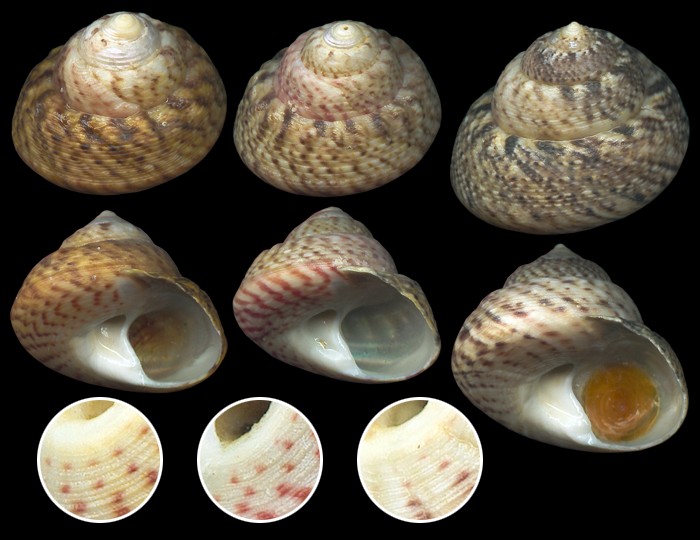 |
Shells found at the foot of the causeway, in 20-50cm deep among rocks, stones and gravel. They are so easily confused
with their environment that the only means to fish them is to pick all the spherical little pebbles that you think doubtful. Sometimes, it's
a magus, sometimes just another piece of rock. Moreover, hundreds of people cross the channel each day of summer, and never find one, but
Oysters, dead Veneridae and Mussels. Notice the punctuation on the base, compared with the zigzag patterns of the specimens from the north.
22-26mm, August 2004. |
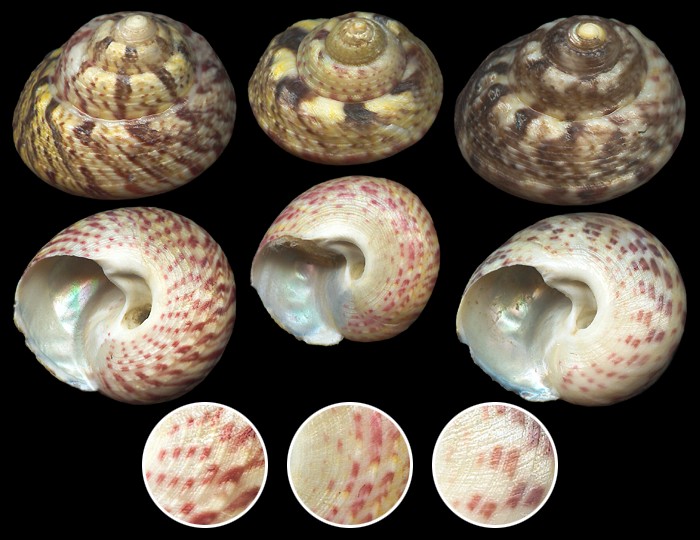 |
Shells collected at 1-1,5m deep, 50m below the road, in a place rarely exposed to air. The main pattern is
now the helicoidal alternance of large bands on the shoulder, a feature that becomes prevalent in deeper waters. This tendency was still noticed
on the northern coast, as seen before. 22-26mm, August 2004. |
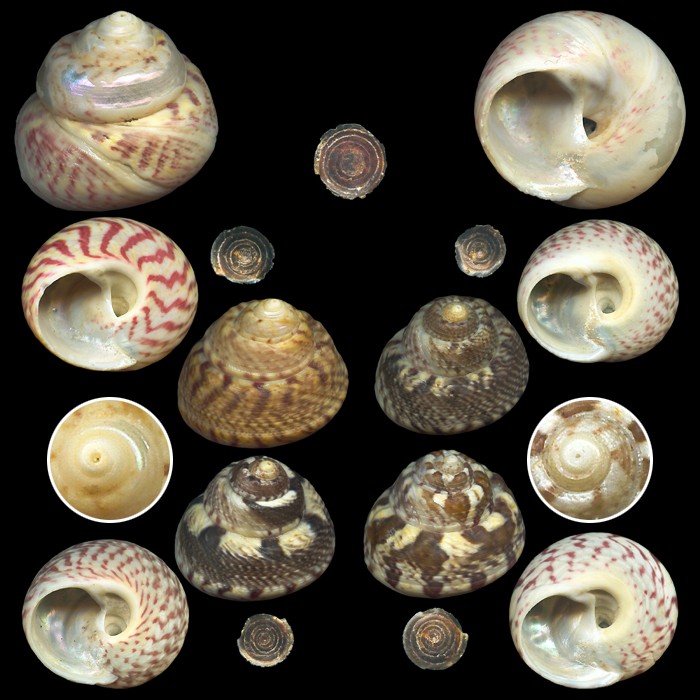 |
Shells collected at 2m deep under the extreme low tide level.
The big one (30mm) comes from Saint Jacut (the previous spot in N. Brittany), a streamy and stormy place.
The smaller ones (23-24mm) come from the SW. end of Berder island, in the channel, on muddy gravel.
Even if this last spot is always quiet and sheltered, the apices remain eroded. |

So, the representative shells are certainly not those commonly found in collections. There, are shown the somptuous patterns,
the most powerful colours, while the little dirty thing lives happy and unknown in the intertidal area, this place so dangerous,
but so rich of possibilities and treasures given by the land.
 Here, even the Sea-Hares have the shape and the colour of dead Ficus roots; at low tide, these animals are thus invisible, and sleep sheltered
within their cocoon of mucus. They are hundreds that snooze around you, and you don't see them, while the pale shape of a stupid worn valve catches your eyes,
again and again, even after thirty years of beachcombing.
 To conclude: I suppose that the deeper they live, the more collectible these shells are. In intertidal areas, the majority bears a kind of camouflage that is adapted to the environment,
in order to avoid predators, tourists and shell collectors. Thus, these specimen are not extremely tremendous, as they try to be stones.
 In deeper water, the pattern shows this alternance of contrasted bands, and one can suppose it is a new kind of camouflage, even if I have difficulties to imagine who could be the ennemy.
 Item Item, the red becomes the main colour, a feature that could be explained by 1) the fact that, underwater, the red is not a colour; 2) the fact that the Maerl and many other subtidal algae (micro and macro) are red.
 Then, to close this chapter, a picture of a true collector's magus, RED. Cheers! O. Caro. |
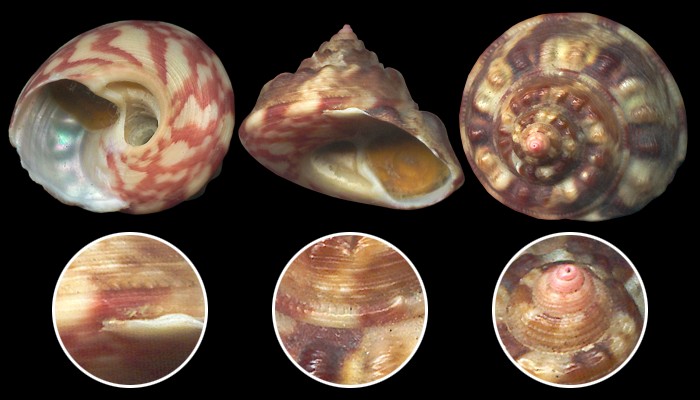 |
Italy. 25mm. These mediterranean specimens deserve to be admired. What a shape, and what a sculpture!
We are far from the rustic pellets of Little Britain. |
| [Summary] |
